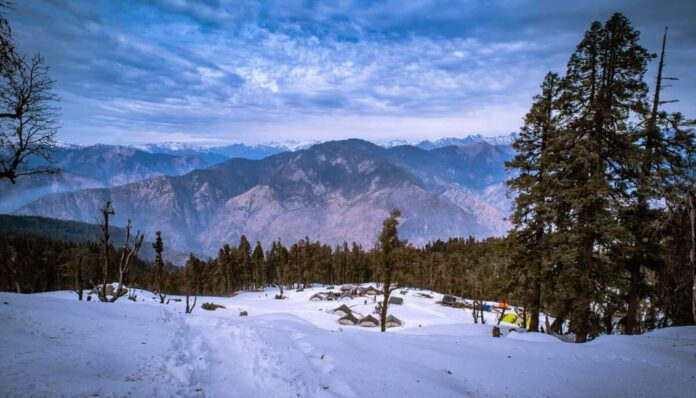The Kedarkantha Trek, nestled in the Garhwal region of Uttarakhand, India, is a popular winter trekking destination. It offers breathtaking views of snow-capped peaks, dense pine forests, and meadows adorned with vibrant flora. One of the essential aspects to consider before embarking on this trek is understanding the distance one needs to cover.
Overview of Kedarkantha Trek Distance
Distance Covered Each Day
The Kedarkantha Trek typically spans over four days, with varying distances covered each day. It’s crucial to gauge the distance to ensure proper planning and preparation.
Total Distance of the Trek
The total distance of the Kedarkantha Trek varies depending on the route taken and the starting point. Trekkers usually cover approximately 20-25 kilometers during the entire journey.
Factors Affecting Kedarkantha Trek Distance
Several factors influence the distance covered during the Kedarkantha Trek.
Terrain and Altitude
The rugged terrain and increasing altitude significantly impact the distance covered each day. As trekkers ascend, the distance might seem shorter due to challenging terrains and altitude gain.
Weather Conditions
Weather conditions, especially during winter months, can affect the pace of the trek. Snowfall and icy trails may slow down the progress, requiring additional time to cover the planned distance.
Fitness Level of the Trekkers
The fitness level of trekkers plays a crucial role in determining how quickly they can cover the distance. Well-prepared individuals with adequate physical fitness may find it easier to traverse the trails.
Best Time to Go on the Kedarkantha Trek
If you’re an avid trekker or an adventure enthusiast, the Kedarkantha Trek should undoubtedly be on your bucket list. Nestled in the lap of the majestic Himalayas, this trek offers breathtaking views, serene landscapes, and a chance to immerse yourself in nature’s embrace. However, choosing the right time to embark on this journey is crucial to ensure an unforgettable experience.
Spring: Embrace the Blossoming Beauty
Spring, spanning from March to April, marks the onset of the trekking season in Kedarkantha. As the snow begins to melt, the trail comes alive with vibrant hues of wildflowers, creating a picturesque canvas against the backdrop of snow-capped peaks. The weather during this time remains pleasant, with clear skies offering unobstructed views of the surrounding peaks.
Summer: Conquer the Summit Amidst Pleasant Weather
Summer, extending from May to June, presents an ideal window for adventurers seeking to conquer the Kedarkantha summit. With the snow mostly melted, the trail becomes more accessible, making it perfect for both seasoned trekkers and beginners. The mild temperatures during this season ensure comfortable trekking conditions, allowing you to fully immerse yourself in the natural beauty that surrounds you.
Monsoon: Witness Nature’s Dramatic Transformation
While the monsoon months of July and August bring intermittent rainfall to the region, they also usher in a unique charm to the Kedarkantha Trek. The lush greenery that blankets the landscape contrasts starkly with the snow-dusted peaks, creating a dramatic yet mesmerizing tableau. However, trekkers must exercise caution during this time, as the trails can become slippery and prone to landslides.
Day-wise Breakdown of Kedarkantha Trek Distance
Day 1: Sankri to Juda ka Talab
The first day typically involves covering around 4-5 kilometers from Sankri to Juda ka Talab, a beautiful campsite beside a serene lake.
Day 2: Juda ka Talab to Kedarkantha Base
On the second day, trekkers trek for approximately 6-7 kilometers to reach the Kedarkantha Base camp, surrounded by panoramic views of snow-clad peaks.
Day 3: Kedarkantha Base to Kedarkantha Summit and back
The highlight of the trek, day three, involves a challenging ascent to the Kedarkantha Summit, covering around 6-7 kilometers round trip.
Day 4: Kedarkantha Base to Sankri
The final day requires trekking back from the base camp to Sankri, covering approximately 9-10 kilometers, concluding the memorable journey.
Tips for Managing Kedarkantha Trek Distance
Training and Fitness Preparation
Prioritize physical fitness and endurance training to tackle the distances and altitudes encountered during the trek.
Packing Essentials
Pack light but essential items such as appropriate clothing, trekking gear, water, snacks, and first-aid supplies to ensure comfort and safety throughout the journey.
Hydration and Nutrition
Stay adequately hydrated and nourished during the trek to maintain energy levels and combat altitude-related challenges effectively.
Conclusion
Understanding the distance involved in the Kedarkantha Trek is vital for proper planning and preparation. By considering factors such as terrain, weather conditions, and personal fitness, trekkers can embark on this exhilarating journey with confidence and enjoy the stunning vistas offered by the Himalayan landscape.
FAQs (Frequently Asked Questions)
- Is the Kedarkantha Trek suitable for beginners?
Yes, the Kedarkantha Trek is considered suitable for beginners with moderate fitness levels. However, adequate preparation and acclimatization are essential. - What is the best time to undertake the Kedarkantha Trek?
The best time for the Kedarkantha Trek is during the winter months, from December to April, when the region is covered in snow, offering breathtaking views. - Are there any age restrictions for the Kedarkantha Trek?
While there are no specific age restrictions, individuals should be in good health and physical condition to undertake the trek. - Do I need to hire a guide for the Kedarkantha Trek?
While it’s not mandatory, hiring a local guide is recommended for safety and navigation purposes, especially for first-time trekkers. - What should I do in case of an emergency during the trek?
In case of an emergency, stay calm, assess the situation, and seek assistance from fellow trekkers or guides. It’s essential to carry a fully charged phone and emergency contacts.

